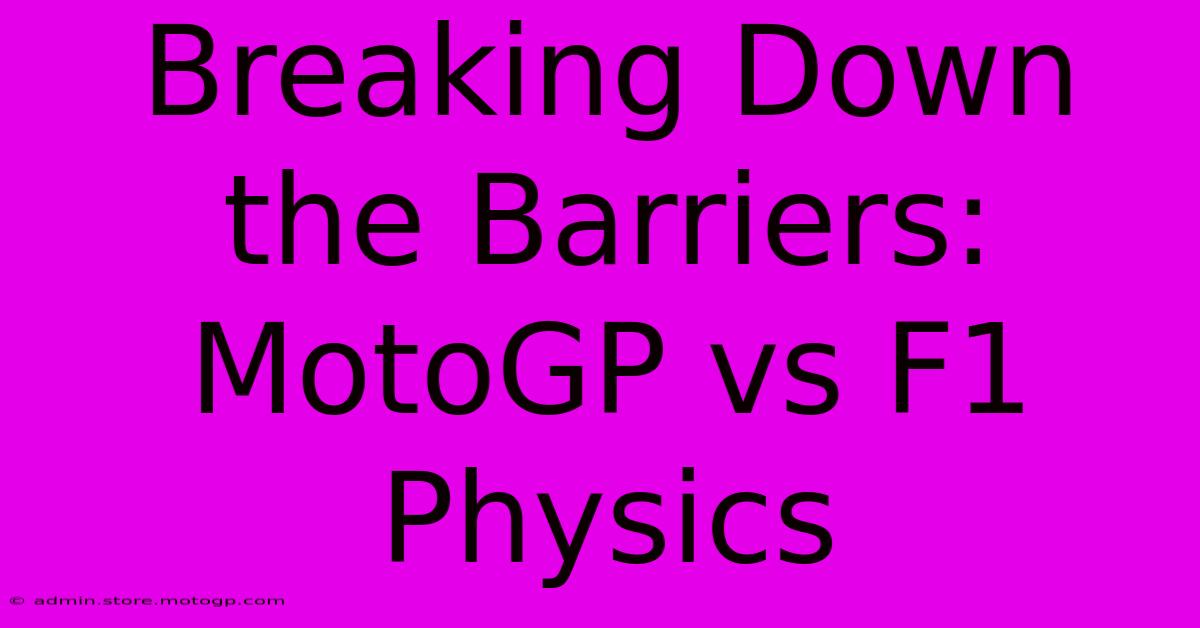Breaking Down The Barriers: MotoGP Vs F1 Physics

Table of Contents
Breaking Down the Barriers: MotoGP vs F1 Physics
The roar of the engines, the breathtaking speeds, the nail-biting competition – Formula 1 and MotoGP share a captivating allure for motorsport fans worldwide. But beneath the surface of shared adrenaline lies a fundamental difference: the physics at play. While both disciplines push the boundaries of engineering and human performance, the contrasting designs of their vehicles lead to vastly different physical challenges. This article delves into the key distinctions in the physics governing these two motorsport giants.
The Two-Wheeled Beast vs. The Four-Wheeled Machine: Fundamental Differences
The most obvious difference lies in the number of wheels. This seemingly small detail drastically alters the dynamics of the vehicle. MotoGP bikes, with their two wheels, rely heavily on lean angle to navigate corners. This requires a delicate balance of rider skill and bike design to prevent a catastrophic crash. The bike's center of gravity plays a crucial role; shifting it subtly affects the machine's responsiveness and stability.
F1 cars, on the other hand, use aerodynamics and downforce to maintain grip in corners. Their four wheels provide a more stable platform, allowing for higher speeds through turns. The sophisticated aerodynamics generate significant downforce, pushing the car firmly onto the track, enabling incredible cornering speeds rarely seen in MotoGP.
Aerodynamics: A Tale of Two Approaches
Aerodynamics plays a vital role in both sports, but its application differs significantly. F1 cars are masters of aerodynamics, utilizing complex wings and diffusers to generate substantial downforce. This allows them to corner at incredible speeds, defying the laws of physics seemingly. The design and optimization of these aerodynamic elements is a constant battle between generating downforce for grip and minimizing drag for speed on straights.
MotoGP bikes, while employing aerodynamics, rely on a less pronounced approach. Fairings and winglets contribute to downforce, but the primary focus remains on minimizing drag to achieve high top speeds and efficient cornering. The bike’s lean angle significantly influences its aerodynamic performance.
Tire Technology: Grip and the Battle Against Friction
Tire technology represents another critical area of distinction. MotoGP tires are significantly smaller and have a much smaller contact patch with the track compared to F1 tires. This necessitates a high level of precision and control from the rider, making even minor errors potentially disastrous. Tire wear and degradation are critical factors in race strategy.
F1 cars, with their larger tires and wider contact patches, enjoy greater grip and stability. The tire compounds used in F1 are also constantly evolving, allowing for greater performance and strategic flexibility. However, even with superior grip, managing tire wear and degradation during the race remains a challenge.
Rider Skill vs. Machine Performance: The Human Element
While both sports demand exceptional engineering, the human element plays a more pronounced role in MotoGP. The rider's skill in balancing the bike, controlling its lean angle, and managing tire wear is paramount. It's a symphony of human-machine interaction, where a slight error can lead to a devastating crash.
F1 drivers undoubtedly require immense skill, but the car's superior stability and aerodynamics reduce the margin for error. While driver skill remains crucial, the car's performance plays a more dominant role in determining race outcomes.
Conclusion: A Comparison of Extremes
Ultimately, the differences between MotoGP and F1 physics boil down to a fascinating contrast between two-wheeled agility and four-wheeled stability. MotoGP champions demonstrate exceptional precision and balance, while F1 drivers master the art of high-speed cornering through superior aerodynamic grip. Both disciplines represent the pinnacle of motorsport engineering and human skill, pushing the boundaries of what is physically possible. The next time you watch either sport, remember the underlying physics – a battle between forces that shapes the thrilling races we love.

Thank you for visiting our website wich cover about Breaking Down The Barriers: MotoGP Vs F1 Physics. We hope the information provided has been useful to you. Feel free to contact us if you have any questions or need further assistance. See you next time and dont miss to bookmark.
Featured Posts
-
The Aero Dilemma Balancing Performance And Cost
Feb 20, 2025
-
Tomorrows F1 Grid Can Anyone Stop The Dominant Team
Feb 20, 2025
-
Experience Cota To The Fullest The Interactive Austin F1 Map
Feb 20, 2025
-
Yamaha V4 A Motorcycle That Will Inspire You
Feb 20, 2025
-
F1 Concert A Celebration Of Speed And Music
Feb 20, 2025
